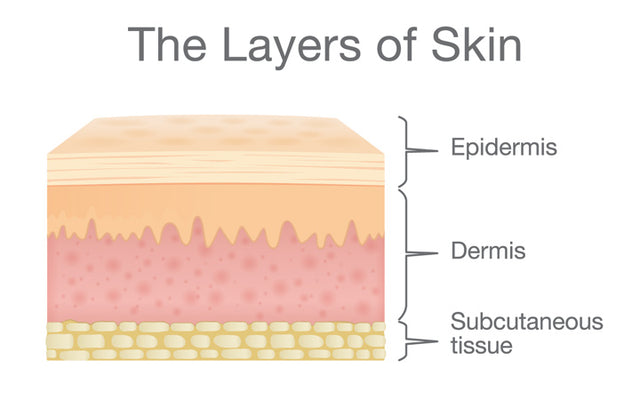Your journey towards achieving healthy skin can’t be complete till you understand it completely. The skin is made of different layers, each of which functions differently from one another. Knowing about each layer and function is important to evaluate your skin health and work towards improving it. Let’s begin.
Highlights:
How Many Layers Of Skin Does A Human Have?
Skin is the largest organ in your body and acts as a protective barrier. It is a connective tissue that consists of cells, fibres and extracellular matrix [1]. The three main layers in it are:
- Epidermis
- Dermis
- Hypodermis
Functions Of The Skin’s Layers
1. Epidermis
Epidermis is the outermost layer of your skin, making it the protective barrier which prevents the entry of harmful bacteria, viruses and other foreign substances into the deeper layers. It prevents water loss from the skin and is also responsible for its color due to the presence of melanocytes.
The different layers of epidermis are:
A. Stratum Basale
This is the lowest layer of epidermis and is composed of keratinocytes [2], melanocytes and tactile cells. Keratinocytes produced here constantly undergo cell division and are pushed to the upper layers of the epidermis.
A keratinocyte is a cell composed of keratin, a fibrous protein that gives skin, hair and nails the hard texture. The cells in this layer are attached to the dermal layer of the skin via collagen fibers, referred to as the basement membrane.
B. Stratum Spinosum
This layer is composed of daughter keratinocytes and dendritic cells, which fight infections in the body. Stratum spinosum [3] is shiny in appearance due to protruding structures called desmosomes.
C. Stratum Granulosum
This layer is composed of 3-5 layers of Keratinocytes. It appears grainy [4] due to the changes in keratinocytes that are being pushed to this layer.
D. Stratum Lucidum
This layer has closely packed keratinocyte cells with seleiden, a clear protein rich in lipids. This is the thick skin that you find in your palms and feet and its transparency is due to seleiden.
E. Stratum Corneum
This layer consists of 15-30 layers of dead keratinized cells. They are shed every four weeks. The layer derives its name from the process of keratinization or cornification that happens.

2. Dermis
The second layer below the epidermis is the dermis, which contains collagen, elastin, blood vessels and hair follicles. The sweat glands in this layer produce sweat that helps flush out toxins from the body, keeping it cool. The nerve endings in the dermal layer are responsible for the sense of touch in your body.
This layer also contains sebaceous glands, which produces sebum - the natural oil which keeps the skin lubricated. It has two sub-layers:
A. Papillary Dermis
The collagen and elastin fibers form a loose mesh in this layer. The papillary layer contains adipocytes (fat cells), blood vessels and phagocytes (defensive cells). It also contains lymphatic capillaries, nerve fibers, and touch receptors.
B. Reticular Dermis
This layer contains dense, irregular and vascularized connective tissue. It contains collagen and elastin fibers. Collagen is a fibrous protein that is made of long and thin fibrils that keep the skin cells together. They give strength to the skin. Elastin is a fibrous protein that gives skin its elastic nature.
3. Subcutaneous Tissue
The subcutaneous tissue or hypodermis consists of well-vascularized, loose connective tissue and adipose tissue. The deeper tissues including muscle, tendon, ligament, joint capsule and bone that lie beneath the hypodermis.
This layer maintains the temperature and acts like a cushion or shock absorber. It means that the fat in this layer protects your muscles, bones and internal organs from injuries. The layer also helps attach dermis to the bones and muscles.
How To Take Care Of Skin?
A good skincare routine can help keep the layers of the skin healthy. Opt for a routine that nourishes all the layers of the skin rather than elaborate, exhausting and superficial ones:
A. Cleanse Twice A Day
Cleansing your skin ensures clean skin free of dirt, makeup residue and excess oil. It also helps remove the dead skin cells that may cause dull-looking skin.
B. Moisturize
Moisturizing locks the moisture in the skin and keeps it soft and supple. It also strengthens stratum corneum and prevents water loss.
C. Sunscreen
UA radiation triggers melanocytes in the stratum basale to produce more melanin. This harmful radiation can cause skin damage ranging from dark spots to wrinkles and tan to skin cancer. Use a broad-spectrum sunscreen to protect your skin while you step outdoors.
D. Eat Right
Have a balanced diet rich in fruits and vegetables. Intake of vitamins from natural sources can boost your skin's health.
Now that you have a good understanding of your skin, do you think it will help you take the right steps for its care?
Recommended Products
Was this Article helpful?
- Least helpful
- Most helpful





